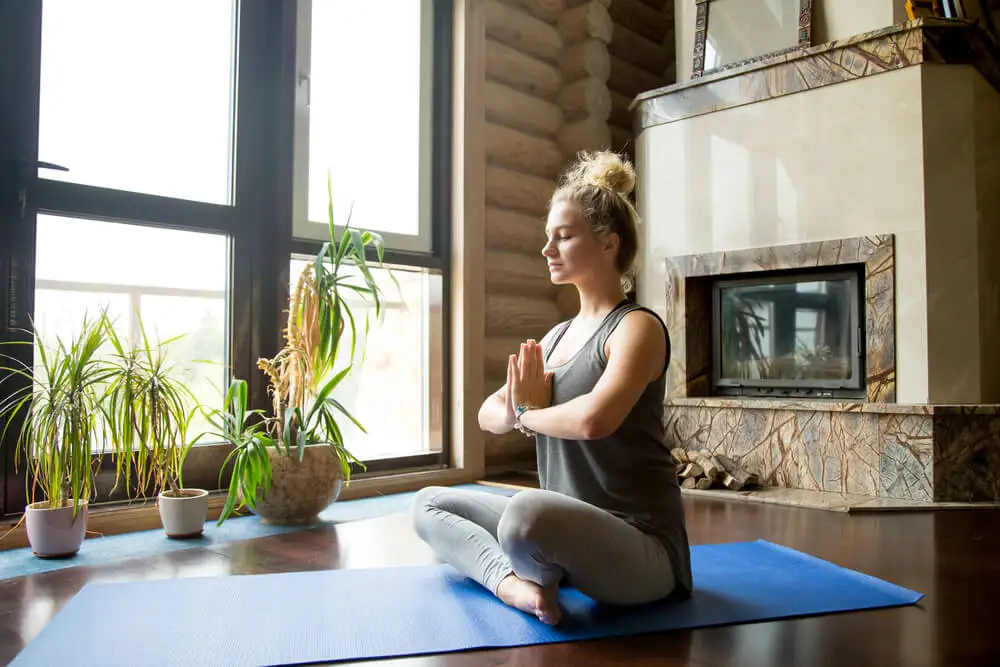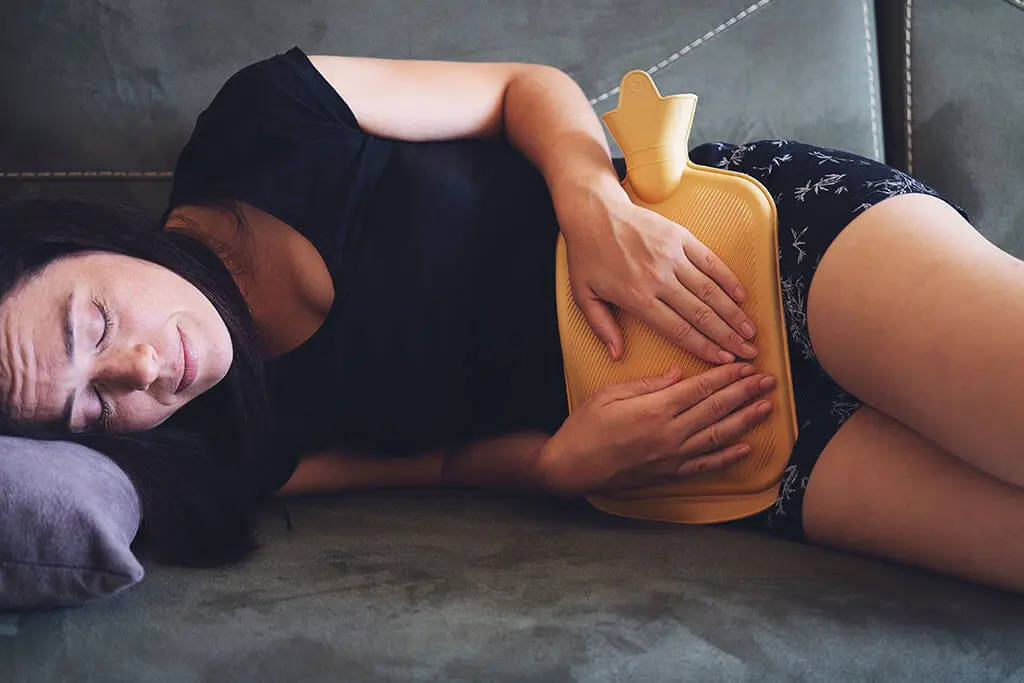7 Exercises and Stretches for Endometriosis Pain Relief


Reviewed and approved by the doctor Leonardo Biolatto
Severe menstrual cramps need medical attention. These discomforts may be related to endometriosis, a condition that requires medical treatment and complementary therapies to relieve endometriosis pain.
The diagnosis is alarming. In fact, figures from the World Health Organization (WHO) report that it affects at least 190 million women and girls of reproductive age worldwide. This gynecological condition impairs the person’s quality of life, because the level of pain makes it difficult for them to function normally.
In order to raise awareness of the issue, the European Endometriosis Alliance promotes campaigns to encourage research, seek social benefits, and spread information to reduce detection time. For this reason, exercise has been highlighted as one of the options that can minimize the inconvenience.
What is endometriosis and what are its symptoms?
Endocrine Reviews describe endometriosis as a complex syndrome, manifested through a chronic inflammation that affects the pelvic tissue and the ovaries. As a consequence, there’s a detachment of an endometrial-like lining, which moves towards the lower abdominal cavity, causing severe pain.
The evolutionary process is unpredictable, as the Clínica Universidad de Navarra points out. Some women have small endometrial implants that don’t change over time, but in others they may develop extensively within the pelvis.
As the symptoms vary, diagnosis is more difficult. Therefore, the signs should be considered, which are usually as follows:
- Fatigue
- Minor bleeding
- Uncomfortable urination
- Irregular periods
- Bleeding between periods
- Dyspepsia, nausea, and vomiting
- Uncomfortable bowel movements
- Pain in the back, pelvis, and legs
- Pain during periods, ovulation, and during or after sexual intercourse
The medical approach selects treatment in a stepwise manner. First, over-the-counter painkillers are prescribed, and then hormone therapy is used. But if none of these options relieves symptoms, surgery may be necessary.
Endometriosis is a disease linked to infertility.
How does exercise help endometriosis pain relief?
Along with all the medication options, and even surgery, physical activity is essential to recovery. So much so that it’s considered a complementary method to relieve endometriosis pain and increase antioxidant and anti-inflammatory markers.
The Center for Young Women’s Health argues that exercise promotes the release of endorphins, natural painkillers. In addition, any type of training improves blood flow and minimizes the amount of circulating estrogens, which means the reduction of endometriosis symptoms.
For its part, the Victoria Eugenia Hospital, which belongs to the Red Cross, emphasizes the importance of relaxing the pelvic and lumbar area through postures and stretching. They add that deep breathing is positive for the muscles in this area.
And as if that weren’t enough, a university research study highlights that combining a diet plan with physical exercise reduces the pain caused by the pathology.
Exercises and stretches that soothe endometriosis pain
Sports are great for health in general. However, in the specific case of acute pelvic pain, exercises that work on the extension of the muscle group in question, as well as breathing exercises, are the most suitable.
Preferably, you should carry out any exercise under the guidance of an expert in the management of chronic conditions.
1. Yoga against endometriosis pain
A study published by the International Journal of Yoga concluded that this discipline reduces dependence on non-steroidal anti-inflammatory drugs (NSAIDs). It states that it is beneficial, relieving chronic pelvic pain and contributing to patients’ quality of life.
In the same vein, the Journal of Alternative and Complementary Medicine highlights that yoga helps to identify bodily and psychosocial mechanisms that produce pain in women, thanks to the mind-body integration.

1.1 Supine spinal twist
The purpose of this position is to stretch the buttocks, chest, and back and soothe myofascial pain in the spine. It should be performed as follows:
- Place pillows or yoga blocks under your back and sacrum.
- Lying on your back, rest your feet on the floor and bend your knees.
- Extend your arms out to the side, with your palms touching the floor.
- Inhale, drawing the air towards the abdomen and lower ribs.
- Exhale and lower your knees towards the left.
- Hold the position as you take 5 deep breaths.
- Return to the starting position and repeat the whole process, but this time turning your knees to the right.
1.2 Restorative pose
The restorative goddess pose in its lying down option balances the nervous system, opens the hips and chest wall, and relaxes. To reach this point apply the following guide, respecting the order:
- Use a bolster under the thighs, forming a support with cushions and yoga blocks.
- Lie down, making sure your head and spine are supported by the pillows.
- Stretch and relax your arms out to the sides, palms facing up.
- Breathe and concentrate in this position for 3 to 10 minutes.
1.3 Tied angle reclining pose
With this asana you de-stress and slightly stretch the abdomen, lessening pelvic discomfort. Carry it out as we’ll tell you below, using cushions or yoga blocks to make it more comfortable:
- In a sitting position, bring your knees to your sides and the soles of your feet together.
- Lie down, and focus on the ceiling.
- Stretch your arms along your body, although you can also place your hands on your belly.
- Stay in this posture for 5 minutes.
2. Diaphragmatic breathing
The Chilean Journal of Obstetrics and Gynecology published an experiment in which 15 women with endometriosis found a relationship between pain management and breathing, claiming that techniques, mainly linked to yoga, increased their capacity for introspection and influenced relief.
With diaphragmatic breathing, you relieve tension from the neck to the pelvis and expand the ribs. Using a yoga strap on the lower rib cage will have better effects.
Just put on the strap and take 5 to 10 deep breaths per minute, lying on your back on the floor, bending your knees a little.
3. Stretching the hip flexor
This dynamic is helpful, lengthening the connective tissue and stretching the belly, pelvis, chest, and the front part of the hips. First you practice it with one leg and then the other:
- Kneel on a mat, blanket, or towel
- Step forward with one foot
- Rest and raise your arms toward the ceiling
- Move forward, lifting your belly
- Breathe until you feel comfortable
- Stay in this position for 1 minute and notice how the pelvic floor distends
4. Visualizations of the pelvic floor
This consists of relaxing the pelvic floor, lying down facing upwards, and with a slight bending of the knees. This exercise is recommended for those who feel pain during sexual intercourse.
To soothe the discomfort you need to visualize mental images while you develop diaphragmatic breathing. Think of the waves generated by a stone falling into a pond, but transferring the scene to your pelvic floor. The aim is to perceive the looseness of the muscles.
Another possible visualization is to project an elevator descending on the pelvis and the doors opening.
5. Extension of hips and buttocks
These are stretches that relieve low back pain linked to problems with the endometrium. The practice is as follows:
- Lie on your back in bed.
- Bend your knees and rest your feet on the mattress.
- One heel goes over the knee of the opposite leg, simulating a number “4” with the lower extremities.
- Use one hand to gradually push your leg through the knee, amplifying the stretch.
- Throughout the movement, the back, shoulders, and head remain relaxed, without leaving the mattress.
6. Shell lengthening
This is a restorative posture that expands the diaphragm and lengthens the pelvic floor. It’s performed as described above:
- Sit back on your heels and curl your body forward
- Extend your arms forward
- If you wish, stretch your knees
- Spend a minute in this posture, working on your breathing

7. Dilation of the groin
Apart from stretching the pelvic floor, the coccyx is softened and pain is reduced. The basis of the procedure is to lie down, raise your knees towards your chest and then slowly spread them apart towards the shoulders. Hold the position for 1 minute, take a deep breath and return to the starting point.
Find out more: Remedies, Symptoms and Causes of Endometriosis
Does exercise carry any risk as an endometriosis pain therapy?
Except for certain practices that should be avoided, recent studies hint that regular exercise can reduce the risk of endometriosis, as stated by the Western New York Urology Association. They allude to research in which women with regular physical activity habits since before they were 15 showed less propensity to the disease.
Frequent sports routines make the pathology more bearable. As for the circuits that you should avoid, we can mention high-intensity abdominal exercises, burpees, and races, because these would increase the discomfort.
All cited sources were thoroughly reviewed by our team to ensure their quality, reliability, currency, and validity. The bibliography of this article was considered reliable and of academic or scientific accuracy.
- Bahamondes L, Filice Barros N, Makuch M, Setubal M, Vasconcelos Gonçalves A. Un estudio cualitativo sobre la práctica de yoga para mujeres con endometriosis asociada al dolor. Diario de Medicina Alternativa y Complementaria. Vol. 22. Núm. 12. pp. 977-982. https://pubmed.ncbi.nlm.nih.gov/27552065/
- Baraño R. Pensando en endometriosis. Revista SAEGRE. Vol. 22. Núm. 1. Argentina; 2015. http://www.saegre.org.ar/revista/numeros/2015/n1/6-9-2015n1.pdf
- Bernardi L, Bulun S, Kohlmeier A. Liu S, Milad M, Miyazaki K, Sison C, Wei J, Yilmaz B, Yin P. Endometriosis. Reseñas endocrinas. Reino Unido; 2019. https://www.mendeley.com/catalogue/19b8ea08-02c0-3048-ae44-50ced071025d/?utm_source=desktop&utm_medium=1.19.4&utm_campaign=open_catalog&userDocumentId=%7Bf05fcce9-9ee0-462f-8188-d8bff98a42d7%7D
- Chiva De Agustín L. Endometriosis. Clínica Universidad de Navarra. España. https://www.cun.es/enfermedades-tratamientos/enfermedades/endometriosis
- ¿Cómo mejorar los síntomas de la endometriosis? Hospital Victoria Eugenia. Cruz Roja. España. https://hospitalveugenia.com/fisioterapia-sevilla/tratamiento-sintomas-endometriosis-con-fisioterapia/
- Endometriosis. Organización Mundial de la Salud. 2021. https://www.who.int/es/news-room/fact-sheets/detail/endometriosis
- Endometriosis: Nutrición y Ejercicio. Centro para la Salud de la Mujer Joven. Estados Unidos; 2020. https://youngwomenshealth.org/guias/endometriosis-nutricion-y-ejercicio/
- Gupta M, Shankar N, Sandhya J, Saxena A, Saxena R. Efectos de la intervención yóguica sobre las puntuaciones de dolor y la calidad de vida en mujeres con dolor pélvico crónico. Revista Internacional de Yoga. Vol. 10. Núm. 1. pp. 9-15. India; 2017. https://www.ncbi.nlm.nih.gov/pmc/articles/PMC5225749/
- Reduciendo su riesgo de endometriosis. Asociados de Urología del Oeste de Nueva York. Estados Unidos. https://www.wnyurology.com/content.aspx?chunkiid=122972
- Rodríguez Dólera A. La calidad de vida en la endometriosis: Efectividad de un plan dietético y ejercicio físico. Trabajo fin de máster. Universidad Miguel Hernández. España; 2020-2021. http://dspace.umh.es/bitstream/11000/8167/1/RODR%c3%8dGUEZ%20D%c3%93LERA%2c%20%c3%81NGELA.pdf
- Vinaccia S, Quiceno J, Quintero Marzola M. Endometriosis: Aspectos psicológicos. Revista Chilena de Obstetricia y Ginecología. Vol. 82. Núm. 4. Chile; 2017. https://www.researchgate.net/publication/320538634_Endometriosis_Aspectos_Psicologicos
This text is provided for informational purposes only and does not replace consultation with a professional. If in doubt, consult your specialist.








